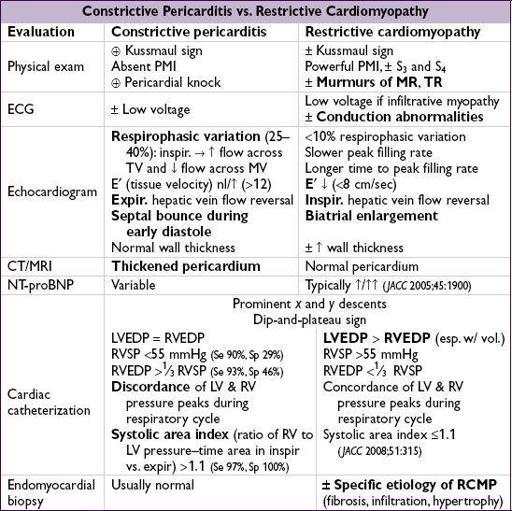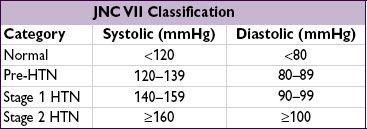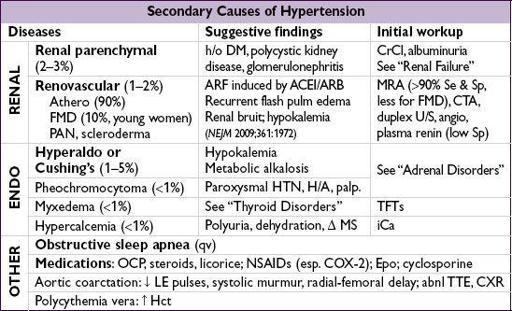Pocket Medicine: The Massachusetts General Hospital Handbook of Internal Medicine (17 page)
Read Pocket Medicine: The Massachusetts General Hospital Handbook of Internal Medicine Online
Authors: Marc Sabatine
Tags: #Medical, #Internal Medicine

BOOK: Pocket Medicine: The Massachusetts General Hospital Handbook of Internal Medicine
5.23Mb size Format: txt, pdf, ePub
if RA pressure remains elevated after drainage, may have effusive-constrictive disease (
NEJM
2004;350:469) or myocardial dysfxn (eg, from concomitant myocarditis)
Treatment
• Volume (but be careful as overfilling can worsen tamponade) andinotropes (avoid bB) • Avoid vasoconstrictors as will ↓ stroke volume & potentially ↓ HR
•
Pericardiocentesis
(except if due to aortic or myocardial rupture, in which case
consider removing just enough fluid to reverse PEA en route to emergent surgery)
CONSTRICTIVE PERICARDITIS
Etiology (
Circ
2011;124:1270)
• Any cause of pericarditis (~1–2% incidence overall after acute pericarditis) • Highest risk w/
TB
,
bacterial
,
neoplastic
, connective tissue, postcardiac surgery •
Viral/idiopathic
, as most common cause of pericarditis, also account for signif proportion
Pathophysiology
• Adhesion of visceral and parietal pericardial layers → rigid pericardium that limits diastolic filling of ventricles → ↑ systemic venous pressures • Venous return is limited only after early rapid filling phase; ∴ rapid ↓ in RA pressure with atrial relaxation and opening of tricuspid valve and
prominent x and y descents
• Kussmaul sign: JVP does not decrease with inspiration (↑ venous return with inspiration but negative intrathoracic pressure not transmitted to heart because of rigid pericardium)
Clinical manifestations (
NEJM
2011;364:1350)
• Right-sided > left-sided heart failure (systemic congestion > pulmonary congestion)
Physical exam
• ↑
JVP
with
prominent y descent
,Kussmaul sign
(Ddx: tricuspid stenosis, acute cor pulmonale, RV failure and RV infarct, RCMP) • Hepatosplenomegaly, ascites, peripheral edema. Consider on Ddx of idiopathic cirrhosis.
• PMI usually not palpable,
pericardial knock
, usually no pulsus paradoxus
Diagnostic studies
• ECG: nonspecific, AF common (up to 33%) in advanced cases • CXR: calcification (MTb most common), esp. in lateral view (although not specific) • Echocardiogram: ± thickened pericardium, “
septal bounce
” = abrupt displacement of septum during rapid filling in early diastole • Cardiac catheterization
atria:
Ms
or
Ws
(prominent
x
and
y
descents)
ventricles:
dip-and-plateau
or
square-root sign
(rapid ↓ pressure at onset of diastole, rapid ↑ to early plateau)
discordance
between LV & RV pressure peaks during respiratory cycle (
Circ
1996;93:2007)
• CT or
MRI
: thickened pericardium (>4 mm; Se ~80%), w/ tethering (
Circ
2011;123:e418)
Treatment
• Diuresis for intravascular volume overload; surgical pericardiectomy in advanced cases • ? MRI able to predict reversibility with anti-inflammatory agents (
Circ
2011;124:1830)
HYPERTENSION
BP should be determined by making ≥2 measurements separated by >2 min. Confirm stage 1 w/in 2 mo; can Rx stage 2 immediately.
Epidemiology (
JAMA
2003;290:199 & 2010;303:2043)
• Prevalence 30% in U.S. adults; >68 million affected (29% in whites, 33.5% in blacks) • Only 50% of patients with dx of HTN have adequate BP control
Etiologies
•
Essential
(95%): onset 25–55 y;FHx. Unclear mechanism but ? additive microvasc
renal injury over time w/ contribution of hyperactive sympathetics (
NEJM
2002;346:913).
↑ Age → ↓ arterial compliance → syst HTN. Genetics also involved (
Nat
ure 2011;478:103).
•
Secondary
: Consider if Pt <20 or >50 y or if sudden onset, severe, refractory HTN
Standard workup
• Goals: (1) identify CV risk factors or other diseases that would modify prognosis or Rx;
(2) reveal 2° causes of hypertension; (3) assess for target-organ damage
• History: CAD, HF, TIA/CVA, PAD, DM, renal insufficiency, sleep apnea, preeclampsia;FHx for HTN; diet, Na intake, smoking, alcohol, prescription and OTC meds, OCP
• Physical exam: ✓
BP in both arms
; funduscopic exam, cardiac (LVH, murmurs), vascular (bruits, radial-femoral delay), abdominal (masses or bruits), neuro exam • Testing: K, BUN, Cr, Ca, glc, Hct, U/A, lipids, TSH, urinary albumin:creatinine (if ↑ Cr, DM, peripheral edema), ? renin, ECG (for LVH), CXR, TTE (eval for valve abnl, LVH)
Complications of HTN
•
Each
↑
20 mmHg SBP or
10 mmHg DBP
→
2
× ↑
CV complications
(
Lancet
2002;360:1903) • Neurologic:
TIA/CVA
, ruptured aneurysms, vascular dementia • Retinopathy: stage I = arteriolar narrowing; II = copper-wiring, AV nicking; III = hemorrhages and exudates; IV = papilledema • Cardiac:
CAD
,
LVH
,
HF, AF
• Vascular: aortic dissection, aortic aneurysm (HTN = key risk factor for aneurysms) • Renal: proteinuria,
renal failure
Treatment (
Lancet
2012;380:591)
• Goal: <140/90 mmHg; if DM or CKD goal is <130/80 mmHg (nb, in DM, target of <120 does not ↓ CV risk & ↑ adverse events;
NEJM
2010;362:1575) •
Treatment results in 50%
↓
HF, 40%
↓
stroke, 20–25%
↓
MI
(
Lancet
2000;356:1955); benefits of Rx’ing stage II HTN extend to Pts >80 y, goal BP <150/80 (
NEJM
2008;358:1887) •
Lifestyle modifications
(each ↓ SBP ~5 mmHg)
weight loss: goal BMI 18.5–24.9; aerobic exercise: ≥30 min exercise/d, ≥5 d/wk
Other books
Iconoclast: A Neuroscientist Reveals How to Think Differently by Gregory Berns Ph.d.
BWWM Interracial Romance 6: Her Protector by Elena Brown
Showers in Season by Beverly LaHaye
Saving Avery by Angela Snyder
Blood Deep by Sharon Page
A by André Alexis
Wedding Night With the Ranger by Lauri Robinson
Tridas by Alan, Mark
Against the Clock by Charlie Moore
Children of the Source by Condit, Geoffrey


